Asus ROG Flow X13 (2021) Review
A lightweight gaming laptop with a heavyweight graphics dock
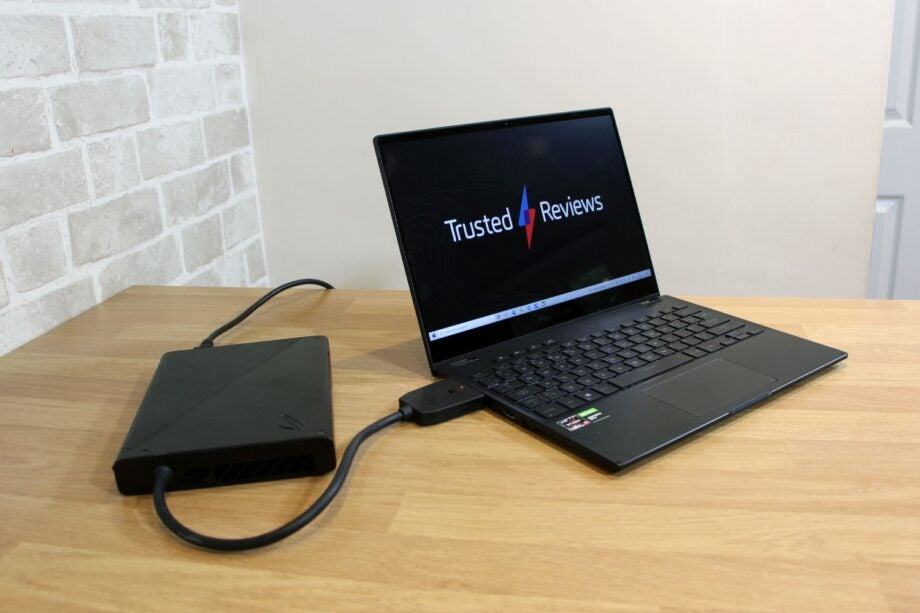

Verdict
The Asus ROG Flow X13 (2021) and ROG XG Mobile provide impressive versatility, power and quality for gaming on the go and at home – it’s the best laptop graphics dock package I’ve seen so far. But there are several strong rivals when it comes to small laptops that offer gaming pace.
Pros
- Superb, versatile design of laptop and dock
- RTX 3080 delivers great gaming speed
- GTX 1650 is a solid eSports chip
- High-quality display
Cons
- Laptop and dock design won’t suit everyone
- Laptop is sometimes too hot
- Middling battery life
- Minimal laptop connectivity
Availability
- UKRRP: £1498
- USARRP: $1769
- EuropeRRP: €1548
Key Features
- A stunning, innovative designThe lightweight laptop and small, powerful graphics dock combine to deliver a versatile option for gaming and working on the move – and at home
- Slim, light and sturdyThe ROG Flow X13 laptop is svelte, robust and easy to use in all modes thanks to its crisp keyboard and impressive touchscreen
- True gaming powerThe laptop RTX 3080 delivers huge gaming power inside a 1kg box that won’t weigh you down
Introduction
The Asus ROG Flow X13 is one of the most surprising laptops I’ve tested recently: it’s a slim, light hybrid that’s absolutely packed with high-end components.
For starters, it features a proper Nvidia graphics card alongside an AMD Ryzen 9 processor. That makes this one of the only hybrids on the market that’s capable of handling games and content-creation.
That’s impressive, and the Flow’s price of £1499 / $1769 / €1549 is surprisingly low considering the hardware on offer. And that isn’t the only option: if you pay £2899 / $3340 / €2999, this laptop also comes with the ROG XG Mobile, which is an external dock with an Nvidia GeForce RTX 3080.
It’s also possible to buy the laptop at the same price with a better RTX 3050 and RTX 3050 Ti graphics cores and weaker Ryzen 9 5900HS processors, but availability is limited and it currently isn’t bundled with the XG Mobile. Keep an eye out, though, as the situation will undoubtedly change.
Design and keyboard
- Superb, sturdy and effective hybrid laptop with slim, light design
- Crisp, impressive keyboard with satisfying typing motion
- Not many ports until you add the impressively lightweight graphics dock
The RTX 3080 dock and Asus ROG Flow X13 make an impressive pair. The reliance on a laptop RTX 3080 means the dock weighs only 1kg and is 30mm thick, and the notebook is a 15.8mm machine that comes in at 1.3kg – so it’s lighter than rivals such as the Razer Blade Stealth, Razer Blade 14 and ROG Zephyrus G14.
Asus reckons that this combination is easier to manage than a conventional laptop: the Flow is ideal if you need a small, light machine for work and eSports, while the dock is for high-end power at home or on the road.
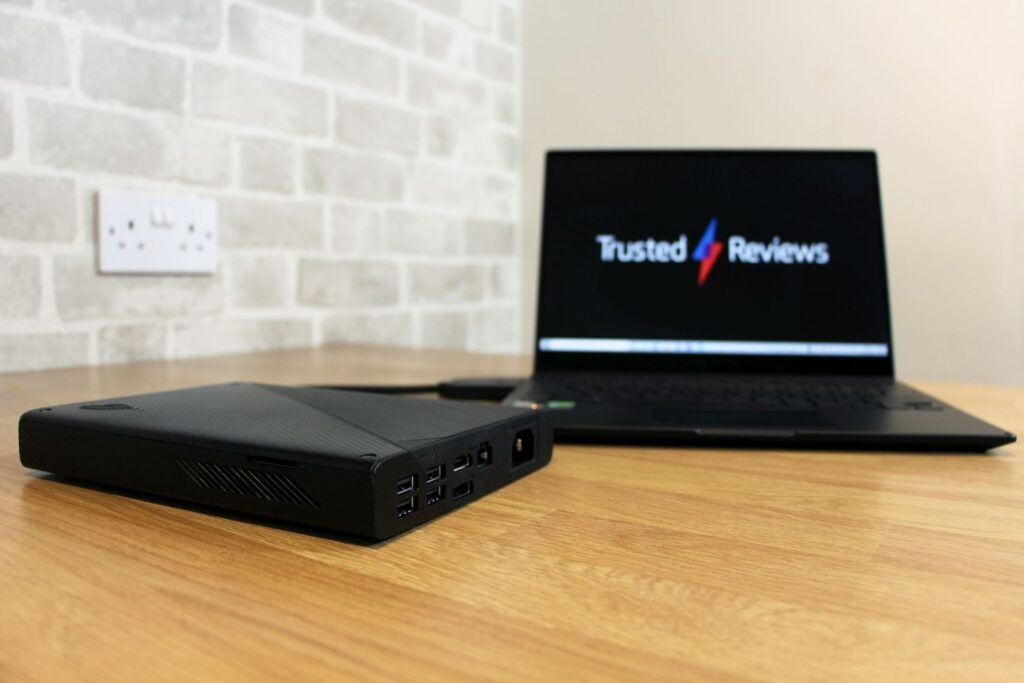
The dock connects to the laptop using a proprietary port on the laptop’s left edge – and it doesn’t just provide extra graphical grunt. It has four USB 3.2 Gen 1 ports, DisplayPort and HDMI outputs, an SD card slot and a Gigabit Ethernet port alongside its power socket.
Those extra ports are welcome when you consider the laptop. It has two USB 3.2 Gen 2 Type-C connections, with one hidden inside the dock’s proprietary port – and one powers the laptop if you don’t use the dock. Elsewhere, there are single audio, HDMI and full-size USB ports.
The Razer Blade 14 and Asus ROG Zephyrus G14 both offer better connectivity than the Flow laptop, and even the Blade Stealth 13 has faster USB-C ports thanks to Thunderbolt.
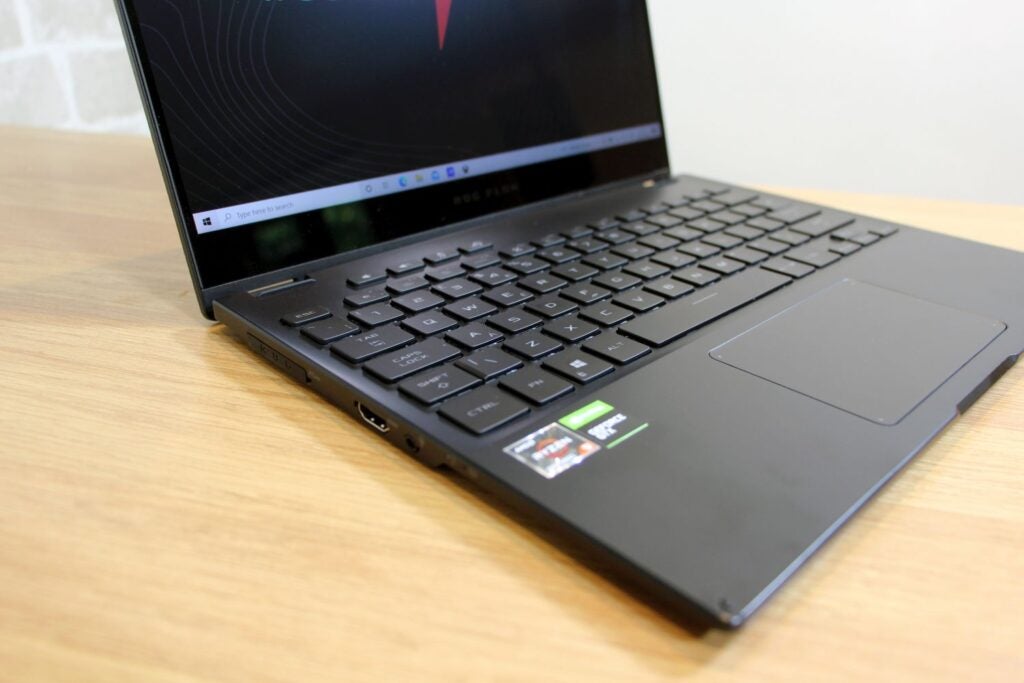
The X13’s body comprises aluminium, magnesium and plastic – and it looks great: subtle with industrial accents, and with the power button and built-in fingerprint reader hidden along the right-hand edge. Build quality is impressive, and the 360-degree hinge movement is smooth, so it’s easy to flip this laptop into tablet mode.
The compact size does mean that the keyboard lacks a numberpad. Its buttons aren’t huge, but they’re decent – crisp, quick and consistent, with a solid base. There’s reasonable travel, so the Flow’s keyboard is good enough for mainstream gaming – and just as good as the hardware on rivals.
Don’t expect much from the trackpad, though: it’s fine, but anyone who wants to enjoy gaming properly should attach a USB mouse.
Screen
- Huge contrast and accurate colours create a vibrant display for games
- The 16:10 aspect ratio and 120Hz refresh rate are good mainstream choices
- The speakers are surprisingly punchy, and solid for games and media
The Asus ROG Flow X13’s 13.4in touchscreen uses a 16:10 aspect ratio, so you’ve got a little extra height, and it’s available in two resolutions.
The model reviewed here has a 1920 x 1200 figure alongside a mid-range 120Hz refresh rate, and the alternative spec has a 3840 x 2400 resolution that runs at 60Hz. The former is better for eSports, thanks to its extra speed, and the latter is more suited to creative workloads.
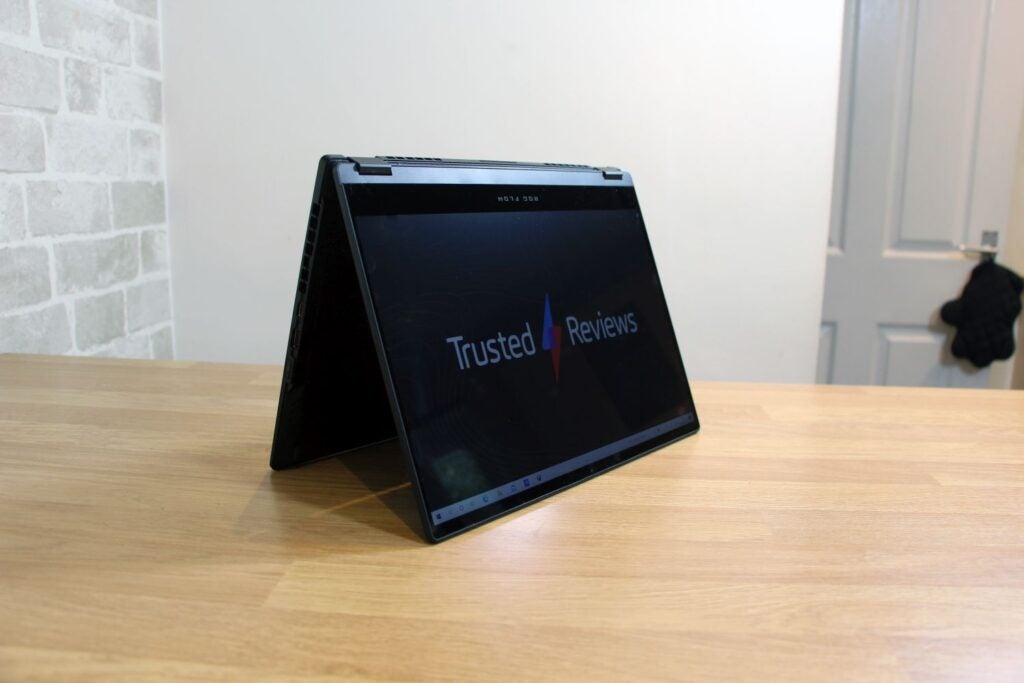
Quality levels are impressive. The backlight sits at 297 nits and pairs with a superb black point of 0.17 nits, so there’s plenty of punch and depth. The resulting contrast ratio of 1747:1 is brilliant, too, delivering plenty of nuance and vibrancy. The Delta E of 0.82 is a top-notch result, and the display renders a rock-solid 97.3% of the sRGB colour gamut. Games look great on this panel.
Surprisingly, the speakers are good too. There’s impressive bass considering the Flow’s size, and the mid-range and top-end sounds are accurate. This hardware is easily good enough for games.
Performance
- Laptop GPU is ideal for eSports, and dock’s RTX 3080 is a powerhouse
- The AMD processor is great for content-creation, but rivals are better
- The Asus is sometimes too hot, and its battery life is middling
The Asus ROG Flow X13’s Nvidia GTX 1650 Max-Q has a modest 1024 stream processors, 4GB of dedicated memory and a peak power level of 40W. The dock’s Nvidia RTX 3080 has a mighty 6144 stream processors, 8GB of memory and a peak power point of 150W – and it can handle ray-tracing and DLSS.
The laptop’s Ryzen 9 5980HS processor is a low-power version of AMD’s high-end laptop chips, and it has eight multi-threaded cores alongside impressive base and boost speeds of 3GHz and 4.8GHz. The rest of the specification is decent: there’s 32GB of memory and a 1TB SSD, and connectivity comes from dual-band WiFi 6 and Bluetooth 5.1.
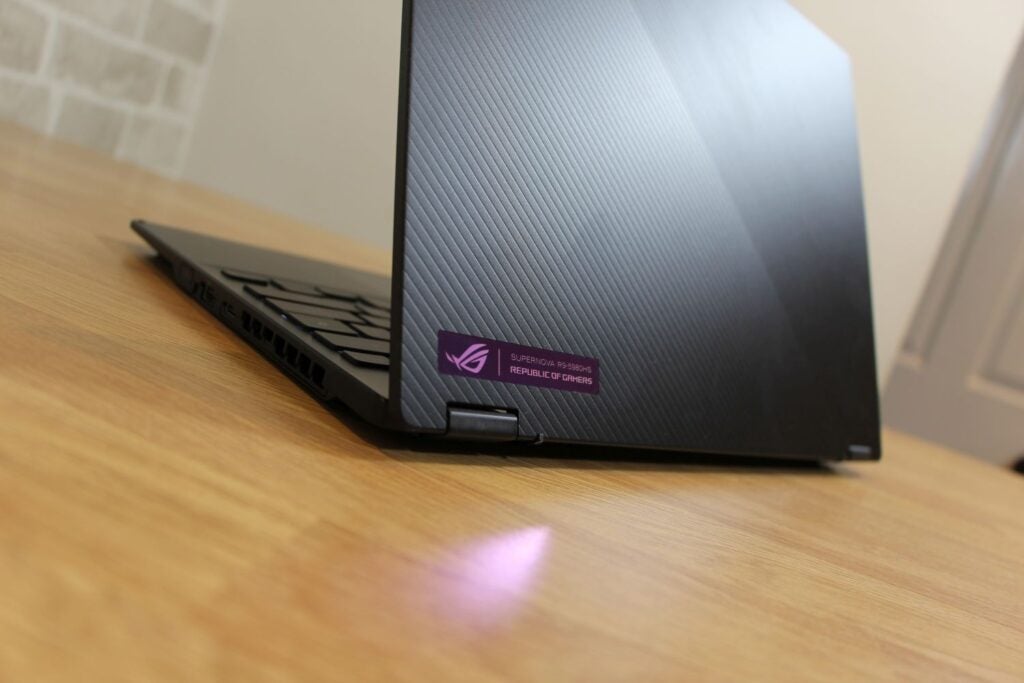
The docked RTX 3080 provides lots of gaming power. It ran Horizon Zero Dawn’s toughest graphics settings at 94fps, and played Borderlands 3 at 92fps. In the easier Dirt Rally benchmark, it averaged 121fps. That’s sufficient power for any scenario: you can play top single-player games without compromise, and run eSports titles at the speeds required by the 120Hz display.
The situation is understandably different if you rely on the GTX 1650 Max-Q. It only played Horizon at 32fps, and ran through Borderlands at 40fps. Its best result came in eSports title Rainbow Six Siege, where it rattled through at 122fps – which is easily good enough for play on the 120Hz screen. Indeed, the GTX 1650 is better-suited to eSports: it will play the big titles smoothly, but you’ll have to compromise settings in plenty of single-player games.
A quick look at 3DMark illustrates the difference between the GPUs. In Time Spy the GTX 1650 scored 3306, but the RTX 3080 hit 11,069. In this test the RTX 3050 Ti also scores around 5300, so I recommend buying the RTX 3050 or RTX 3050 Ti laptops rather than the GTX 1650 machine if possible, especially if it comes bundled with the dock.
Not surprisingly, the RTX 3080 is faster than the RTX 3060 and RTX 3070 cores included in rivals. It’s better than the 100W RTX 3080 in the Razer Blade 14, too.
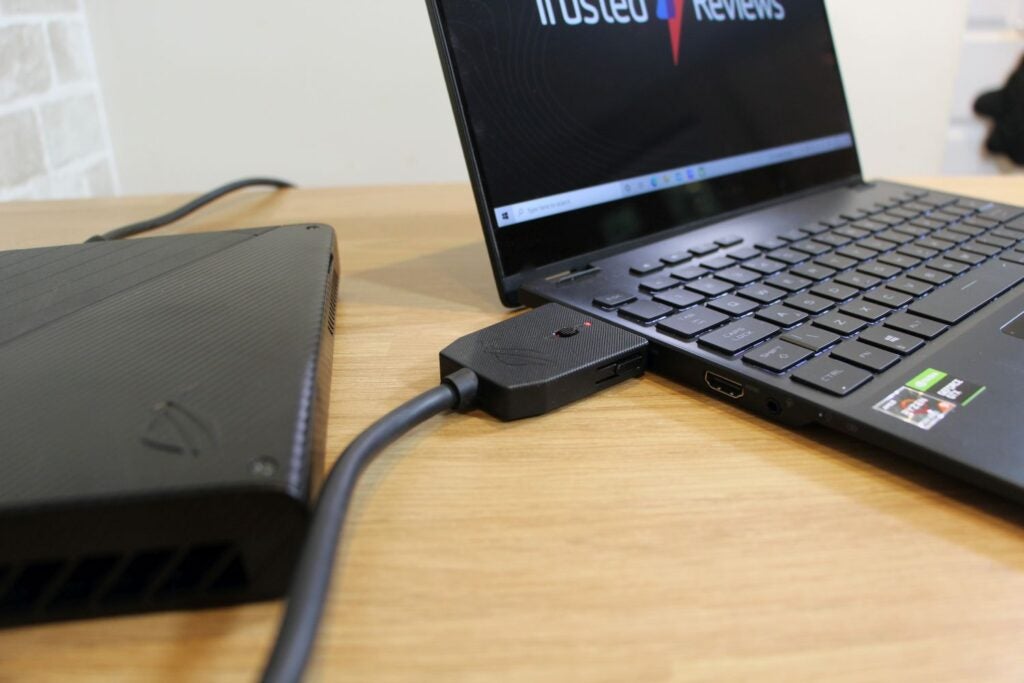
Conversely, larger and thicker gaming laptops sometimes run the RTX 3080 at a peak of 165W, so they’ll be slighter faster.
The low-power Ryzen 9 5980HS still has plenty of computing ability. In the Geekbench single- and multi-core tests, the Flow returned results of 1357 and 7466. Those scores rose to 1438 and 7932 with the XG Mobile dock connected. There’s enough power here to handle all sorts of tasks: this machine doesn’t struggle with Office apps or dozens of browser tabs open at once, and it has the grunt for mainstream content-creation and streaming.
That’s great, but some rivals go further. The Razer Blade 14 and Asus ROG Zephyrus G14 both rely on full-power Ryzen 9 laptop processors. The Razer is quicker in the single-core benchmark, and the G14 is faster in both tests.
The Flow clearly pushes the limits when it comes to thermal performance, too. There’s some noticeable fan noise during gameplay and tougher work tasks – a headset will be a good option to drown it out. The dock produces similar noise, too. There’s noticeable heat output: the laptop’s underside becomes hot during intensive use, and the area above the keyboard becomes too hot to touch.
None of this is a surprise, and the Asus isn’t alone here. The G14 is a little cooler and quieter, but it’s hardly subtle. The Blade 14 exhibits similar heat issues alongside slightly less sound.
Battery life
- Lasts for 1 hours and 18 mins when gaming
- Lasts for 5 hours and 30 mins for productivity work
- Dock needs to be plugged into mains to function
The Asus ROG Flow X13 delivers middling battery life. It lasted for 1hr 18mins while gaming, which is a mediocre result.
The ROG Flow X13 also lasted for 5hrs 30mins when working and just over six hours when playing video. The Razer Blade and Asus G14 were both better here.
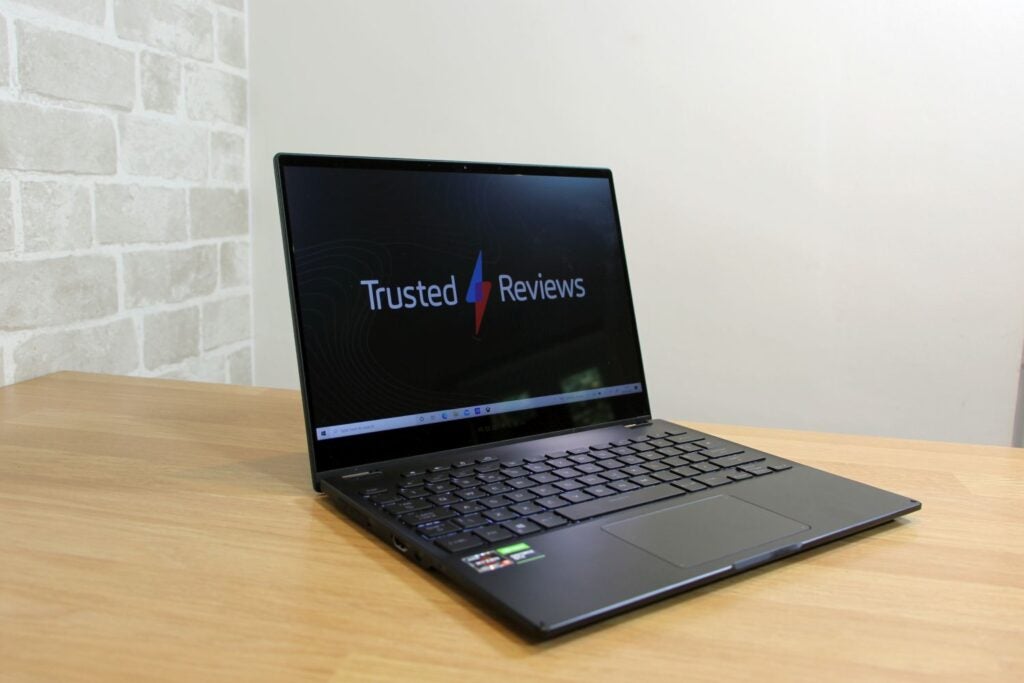
The dock will of course need to be plugged into the mains to function, so you’re not going to be able to benefit from the power of the RTX 3080 while on the move.
Latest deals
Should you buy it?
You want a lightweight, everyday laptop alongside high-end gaming ability The Flow X13 is an excellent, lightweight gaming laptop, with the XG Mobile dock adding power and versatility – it’s a great package.
You only want the high-end gaming power, or you need a bigger screen If you just want pure gaming speed then you’d be better off with a conventional gaming laptop that has the RTX 3080 built-in.
Final thoughts
The Asus ROG Flow X13 (2021) and ROG XG Mobile are a superb combination if you’re after a lightweight eSports and work machine for some days and a gaming beast on others. But be aware that plenty of other small gaming notebooks are available – and that this split form factor doesn’t suit all situations.
How we test
Every gaming laptop we review goes through a series of uniform checks designed to gauge key things including build quality, performance, screen quality and battery life.
These include formal synthetic benchmarks and scripted tests, plus a series of real world checks, such as how well it runs when running a AAA game.
We used as our main laptop for at least a week.
Tested the performance via both benchmark tests and real-world use.
We tested the screen with a colorimeter and real-world use.
We tested the battery with a benchmark test and real-world use.
FAQs
The Asus includes a stylus and a sleeve for the laptop, and some models also include a ROG Chakram Core P511 gaming mouse.
Yes, Asus will provide the free upgrade on these machines.
The Asus and its graphics dock are protected by a one-year warranty.








